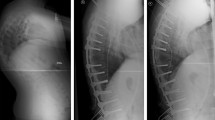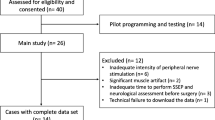Abstract
This study was a retrospective review of 3,806 patients who underwent anterior cervical spine surgery with multi-modality neurophysiological monitoring consisting of transcranial electric motor evoked potentials, somatosensory evoked potentials and spontaneous electromyography between 1999–2003. The objectives of this study were twofold: (1) to evaluate the role of transcranial electric motor evoked potential tceMEP and ulnar nerve somatosensory evoked potential (SSEP) monitoring for identifying impending position-related stretch brachial plexopathy, peripheral nerve entrapment/compression or spinal cord compression and (2) to estimate the point-prevalence of impending neurologic injury secondary to surgical positioning effects. Sixty-nine of 3,806 patients (1.8% showed intraoperative evidence of impending neurologic injury secondary to positioning, prompting interventional repositioning of the patient. The brachial plexus was the site of evolving injury in 65% of these 69 cases. Impending brachial plexopathy was most commonly noted immediately following shoulder taping and the application of counter-traction. Brachial plexus stretch upon neck extension for optimal surgical access and visualization was second in frequency-of-occurrence. Evolving traction injury to the ulnar nerve attributed to tightly-wrapped or malpositioned arms was observed in 16% of alerted cases, whereas evolving spinal cord injury following neck extension accounted for an additional 19%. This study highlights the role of tceMEP and ulnar nerve SSEP monitoring for detecting emerging peripheral nerve injury secondary to positioning in preparation for and during anterior cervical spine surgery.
Similar content being viewed by others
References
Schwartz DM, Wierzbowski LR, Fan D, Sestokas AK. Intraoperative neurophysiological monitoring during spine surgery. In: Vaccaro AR, Betz RR, Zeidman SM, (eds.), Principles and practices of spine surgery. Philadelphia: Mosby 2003; 115–126.
MacDonald DB, Al Zayed Z, Khoudeir I, Stigsby B. Monitoring scoliosis surgery with combined multiple pulse transcranial electric motor and cortical somatosensory-evoked potentials from the lower and upper extremities. Spine 2003; 28: 194–203.
Hilibrand AS, Schwartz DM, Sethuraman V, et al. Comparison of transcranial electric motor and somatosensory evoked potential monitoring during cervical spine surgery. J Bone Joint Surg Am 2004; 86-A: 1248–53.
Bose B, Sestokas AK, Schwartz DM. Neurophysiological monitoring of spinal cord function during instrumented anterior cervical fusion. Spine J 2004; 4: 202–7.
Cooper DE, Jenkins RS, Bready L, Rockwood CA Jr. The prevention of injuries of the brachial plexus secondary to malposition of the patient during surgery. Clin Orthop Relat Res 1988; 228: 33–41.
Baumann SB, Welch WC, Bloom MJ. Intraoperative SSEP detection of ulnar nerve compression or ischemia in an obesepatient: a unique complication associated with a specialized spinal retraction system. Arch Phys Med Rehabil 2000; 81:130–2.
O’Brien MF, Lenke LG, Bridwell KH. Evoked potential monitoring of the upper extremities during thoracic and lumbar spinal deformity surgery: a prospective study. J Spinal Disord 1994; 7: 277–84.
Schwartz DM, Drummond DS, Hahn M. Prevention of positional brachial plexopathy during surgical correction of scoliosis. J Spinal Disord 2000; 13: 178–82.
Jones SC, Fernau R, Woeltjen BL. Use of somatosensory evoked potentials to detect peripheral ischemia and potential injury resulting from positioning of the surgical patient: case reports and discussion. Spine J 2004; 4: 360–2.
Kroll DA, Caplan RA, Posner K, et al. Nerve injury associated with anesthesia. Anesthesiology 1990; 73: 202–7.
Parks BJ. Postoperative peripheral neuropathies. Surgery 1973; 74: 348–57.
Cheney FW, Domino KB, Caplan RA, Posner KL. Nerve injury associated with anesthesia: a closed claims analysis. Anesthesiology 1999; 90: 1062–9.
Lee LA, Posner KL, Cheney FW, Domino KB. ASA Closed Claims Project: an analysis of claims associated with neurosurgical anesthesia. Anesthesiology 2003; 99: A362.
Practice advisory for the prevention of perioperative peripheral neuropathies: a report by the American Society of Anesthesiology Task Force on Prevention of Perioperative Peripheral Neuropathies. Anesthesiology 2000; 92: 1168-2.
Mahla ME, Long DM, McKennett J, et al. Detection of brachial plexus dysfunction by somatosensory evoked potential monitoring–a report of two cases. Anesthesiology 1984; 60: 248–52.
Lederman RJ, Breuer AC, Hanson MR. Peripheral nervous system complications of coronary artery bypass graft surgery. Ann Neurol 1982; 12: 297–301.
Wey JM, Guinn GA. Ulnar nerve injury with open-heart surgery. Ann Thorac Surg 1985; 39: 358–60.
Seyfer AE, Grammer NY, Bogumill GP. Upper extremity neuropathies after cardiac surgery. J Hand Surg 1985; [Am] 10: 16–9.
Hotson JR, Enzmann DR. Neurologic complications after cardiac transplantation. Neuro Clin 1988; 6: 349–65.
Stein DP, Lederman RJ, Vogt DP, et al. Neurologic complications following liver transplantation. Ann Neurol 1992; 31: 644–9.
Lin PY, Luo CY, Kan CD, et al. Brachial plexus injury following coronary artery bypass surgery: a case report. Kaohsiung J Med Sci 2000; 16: 638–42.
Hickey C, Gugino LD, Aglio LS, et al. Intraoperative somatosensory evoked potential monitoring predicts peripheral nerve injury during cardiac surgery. Anesthesiology 1993; 78: 29–35.
Seal D, Balaton J, Coupland SG, et al. Somatosensory evoked potential monitoring during cardiac surgery: an examination of brachial plexus dysfunction. J Cardiothorac Vasc Anesth 1997; 11: 187–91.
Pitman MI, Nainzadeh N, Ergas E, Springer S. The use of somatosensory evoked potentials for detection of neuropraxia during shoulder arthroscopy. Arthroscopy 1988; 4: 250–5.
Author information
Authors and Affiliations
Rights and permissions
About this article
Cite this article
Schwartz, D.M., Sestokas, A.K., Hilibrand, A.S. et al. Neurophysiological Identification of Position-Induced Neurologic Injury During Anterior Cervical Spine Surgery. J Clin Monit Comput 20, 437–444 (2006). https://doi.org/10.1007/s10877-006-9032-1
Received:
Accepted:
Published:
Issue Date:
DOI: https://doi.org/10.1007/s10877-006-9032-1




